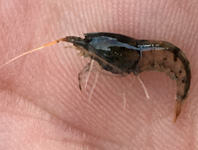Abstract
Hypsibius vaskelae sp. nov. (Tardigrada, Eutardigrada, Hypsibiidae) is described from a freshwater sample collected in the vicinity of Saint-Petersburg. The new species has wrinkled cuticle, bucco-pharyngeal apparatus with two elongate macroplacoids and septulum, and cuticular bars between the bases of inner and outer claw and near the base of the inner claw on legs I–IV. Hypsibius vaskelae sp. nov. is most similar to Hypsibius marcelli Pilato, 1990 and H. septulatus Pilato, Binda, Napolitano & Moncada, 2004, but differs from both in having wrinkled dorsal cuticle, thinner claws, and presence of lunules on the claws of all legs.
References
Bertolani, R. & Rebecchi, L. (1996) The tardigrades of Emilia (Italy). II. Monte Rondinaio. A multihabitat study on a high altitude valley of the northern Apennines. Zoological Journal of the Linnean Society, 116, 3–12.
https://doi.org/10.1111/j.1096-3642.1996.tb02329.xBiserov, V.I. (1991) An annotated list of Tardigrada from European Russia. Zoologische Jahrbücher, Abteilung für Systematik, 118, 193–216.
Doyère, M.L. (1840) Mémoires sur les Tardigrades. Annales de Sciences Naturelles, 2 (14), 269–361.
Gąsiorek, P., Zawierucha, K., Stec, D., Michalczyk, Ł. & Kaczmarek, Ł. (2017) Integrative redescription of a common Arctic water bear Pilatobius recamieri (Richters, 1911). Polar Biology, 40 (11), 2239–2252.
https://doi.org/10.1007/s00300-017-2137-9Kaczmarek, Ł., Parnikoza, I., Gawlak, M., Esefeld, J., Peter, H.-U., Kozeretska, I. & Roszkowska, M. (2018) Tardigrades from Larus dominicanus Lichtenstein, 1823 nests on the Argentine Islands (maritime Antarctic). Polar Biology, 41 (2), 283–301.
https://doi.org/10.1007/s00300-017-2190-4.Li, H. & Li, X. (2008) Two new species of Hypsibiidae (Tardigrada: Eutardigrada) from China. Proceedings of the Biological Society of Washington, 121, 41–48.
https://doi.org/10.2988/07-37.1Maucci, W. (1987) A contribution to the knowledge of the North American Tardigrada with emphasis on the fauna of Yellowstone National Park (Wyoming). In: Bertolani, R. (Ed.), Biology of Tardigrada. Selected Symposia and Monographs. U.Z.I., Mucci, Modena, pp. 187–210.
Maucci, W. (1996) Tardigrada of the Arctic tundra with description of two new species. Zoological Journal of the Linnean Society, 116, 185–204.
https://doi.org/10.1111/j.1096-3642.1996.tb02343.xMiller, W.R., McInnes, S.J. & Bergstrom, D.M. (2005) Tardigrades of the Australian Antarctic: Hypsibius heardensis (Eutardigrada: Hypsibiidae: dujardini group) a new species from sub-Antarctic Heard Island. Zootaxa, 1022 (1), 57–64.
https://doi.org/10.11646/zootaxa.1022.1.3Murray, J. (1907) Scottish tardigrada collected by the lake survey. Transactions of the Royal Society of Edinburgh, 45, 641–668.
https://doi.org/10.1017/S0080456800011777Pilato, G. (1981) Analisi di nuovi caratteri nello studio degli Eutardigradi. Animalia, 8, 51–57.
Pilato, G. (1990) Tardigrada di Terra del Fuoco e Magallanes. II. Descrizione di Hypsibius marcelli n. sp. (Hypsibiidae). Animalia, 17, 95–98.
Pilato, G., Bertolani, R. & Binda, M.G. (1982) Studio degli Isohypslbius del gruppo elegans (Eutardigrada, Hypsibiidae) con descrizione di due nuove specie. Animalia, 9 (1/3), 185–198.
Pilato, G. & Binda, M.G. (2010) Definition of families, subfamilies, genera and subgenera of the Eutardigrada, and keys to their identification. Zootaxa, 2404, 1–54.
Pilato, G., Binda, M.G. & Claxton, S. (2002) Itaquascon unguiculum and Itaquascon cambewarrense: two new species of eutardigrades from Australia. New Zealand Journal of Zoology, 29, 87–93.
https://doi.org/10.1080/03014223.2002.9518293Pilato, G., Binda, M.G. & Lisi, O. (2003) Notes on some tardigrades from Central Africa, with the description of a new species of Hypsibiidae. Zootaxa, 241, 1–7.
https://doi.org/10.11646/zootaxa.241.1.1Pilato, G., Binda, M.G. & Lisi, O. (2006) Three new species of eutardigrades from Seychelles. New Zealand Journal of Zoology, 33, 39–48.
https://doi.org/10.1080/03014223.2006.9518429Pilato, G., Binda, M.G., Napolitano, A. & Moncada, E. (2004) Remarks on some species of tardigrades from South America with description of two new species. Journal of Natural History, 38, 1081–1086.
https://doi.org/10.1080/0022293031000071541Pilato, G., Guidetti, R., Rebecchi, L., Lisi, O., Hansen, J.G. & Bertolani, R. (2006) Geonemy, ecology, reproductive biology and morphology of the tardigrade Hypsibius zetlandicus (Eutardigrada: Hypsibiidae) with erection of Borealibius gen. n. Polar Biology, 29, 595–603.
https://doi.org/10.1007/s00300-005-0094-1Pilato, G., Kiosya, Y., Lisi, O., Inshina, V. & Biserov, V. (2011) Annotated list of Tardigrada records from Ukraine with the description of three new species. Zootaxa, 3123, 1–31.
Pilato, G., Kiosya, Y., Lisi, O. & Sabella, G. (2012) New records of Eutardigrada from Belarus with the description of three new species. Zootaxa, 3179, 39–60.
Rumyantsev, V.A., Drabkova, V.G. & Ismailova, A.V. (2015) Ozera evropeiskoi chasti Rossii [Lakes of the european Russia]. LEMA, Sankt-Peterburg, 392 pp. [in Russian]
Tumanov, D.V. (1997a) Tardigrades in freshwater bentic communities in Northwestern Russia. In: The response of lake ecosystems to changes in biotic and abiotic conditions. Trudy Zoologicheskogo Instituta RAN, 272, pp 330–333. [in Russian]
Tumanov, D.V. (1997b) Hypsibius iskandarovi sp. nov., a new species of Tardigrada from fresh waters of North-West Russia (Tardigrada: Hypsibiidae). Zoosystematica Rossica, 5, 219–220.
Tumanov, D.V. (2003) Four new Isohypsibius species from Russian fresh waters (Tardigrada, Hypsibiidae). Bulletin de l’Institut Royal des Sciences Naturelles de Belgique, Biologie, 73, 183–189.

